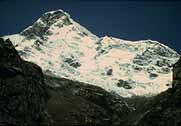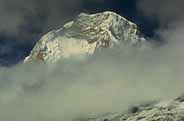 |
Jalca Formations |
 |
 |
Jalca Formations |
 |

|
The Andean Cordillera extends the length of western South America, largely unbroken, for over 7500 kms. It is the dominant physiographic feature of the continent. Its peaks average 3500-4500 m from Colombia to Argentina and form a formidable east-west barrier for plants, animals and man. In Peru, the Andes consist of two parallel ranges, the Cordillera Occidental and Cordillera Oriental. The combination of high elevations and latitudinal range give rise to several types of specialized alpine environments. In northern Peru, between the páramos to the north (Colombia, Ecuador, Venezuela) and puna to the south (southern Peru, northeastern Chile, Bolivia, northwestern Argentina), there exist transitional alpine formations known as jalca. While exacting definitions are lacking, jalca is usually interpreted as drier than páramo and wetter than puna (Weberbaruer, 1945). This climatic transition encompasses a region referred to as the Huancabamba Deflection (or Depression), one of the few pronounced discontinuities in the Andean Cordillera where the mountains bend from NW to NE and become fragmented. Habitat heterogeneity and fragmentation in this region appears to have affected speciation, endemism, and overall biodiversity in both plants and animals. This region can be thought of as a more diverse and complex northern extension of the "altiplano." |
|
click here. |
|
Bolivar (Dpto. La Libertad), click here. |
|
Huancabamba (Dpto. Piura), click here. |
 |
provided by NSF (2000-2003) |
 [Return to ABIS]
[Return to ABIS]